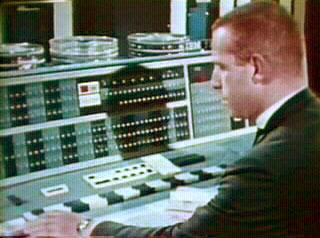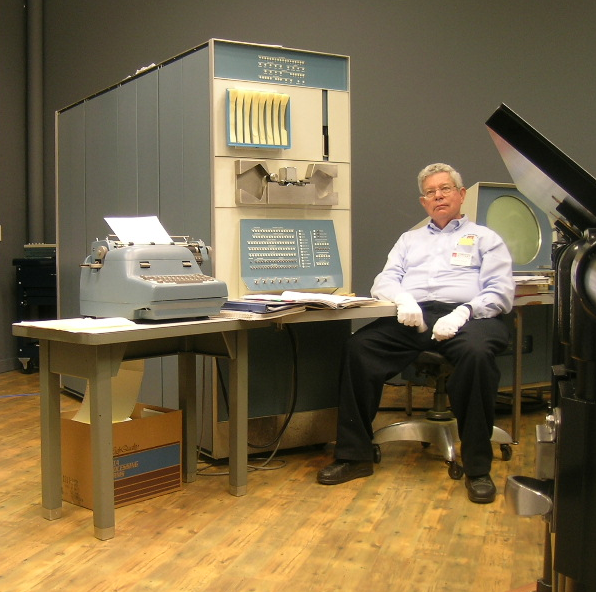|
Sense Switch
A sense switch, or program switch, is a switch on the front panel of a computer whose state can be tested by conditional branch instructions in software. Most early computers had several sense switches. They were typically used by the operator to set program options. IBM's first commercial computer, the IBM 701 Defense Calculator, announced on May 21, 1952, had four lights and six switches on the upper right of its front panel marked Sense (see photo). The switches could be tested and the lights turned on or off under program control. The same number of sense switches and lights were on the front panels of all first and second generation machines in the IBM scientific computer line, the IBM 701, IBM 704, IBM 709, IBM 7090 and the IBM 7094.See photos in the respective articles IBM's Fortran language, first released for the 704, included statements to test the switches and set or reset the lights. *IF (SENSE SWITCH i) n1, n2 *SENSE LIGHT i *IF (SENSE LIGHT i) n1, n2 where n1 a ... [...More Info...] [...Related Items...] OR: [Wikipedia] [Google] [Baidu] |
IBM 701console
International Business Machines Corporation (using the trademark IBM), nicknamed Big Blue, is an American multinational technology company headquartered in Armonk, New York, and present in over 175 countries. It is a publicly traded company and one of the 30 companies in the Dow Jones Industrial Average. IBM is the largest industrial research organization in the world, with 19 research facilities across a dozen countries; for 29 consecutive years, from 1993 to 2021, it held the record for most annual U.S. patents generated by a business. IBM was founded in 1911 as the Computing-Tabulating-Recording Company (CTR), a holding company of manufacturers of record-keeping and measuring systems. It was renamed "International Business Machines" in 1924 and soon became the leading manufacturer of punch-card tabulating systems. During the 1960s and 1970s, the IBM mainframe, exemplified by the System/360 and its successors, was the world's dominant computing platform, with the com ... [...More Info...] [...Related Items...] OR: [Wikipedia] [Google] [Baidu] |
Front Panel
A front panel was used on early electronic computers to display and allow the alteration of the state of the machine's internal CPU register, registers and computer memory, memory. The front panel usually consisted of arrays of electric light, indicator lamps, digit and symbol displays, toggle switches, dials, and push-button, push buttons mounted on a sheet metal face plate. In early machines, Cathode-ray tube, CRTs might also be present (as an oscilloscope, or, for example, to mirror the contents of Williams tube, Williams–Kilburn tube memory). Prior to the development of CRT system consoles, many computers such as the IBM 1620 had console typewriters. Usually the contents of one or more hardware registers would be represented by a row of lights, allowing the contents to be read directly when the machine was stopped. The switches allowed direct entry of data and address values into registers or memory. Details On some machines, certain lights and switches were reserved f ... [...More Info...] [...Related Items...] OR: [Wikipedia] [Google] [Baidu] |
IBM 701
The IBM 701 Electronic Data Processing Machine, known as the Defense Calculator while in development, was IBM’s first commercial scientific computer and its first series production mainframe computer, which was announced to the public on May 21, 1952. It was designed and developed by Jerrier Haddad and Nathaniel Rochester and was based on the IAS machine at Princeton. The IBM 701 was the first computer in the IBM 700/7000 series, which were IBM’s high-end computers until the arrival of the IBM System/360 in 1964. The business-oriented sibling of the 701 was the IBM 702 and a lower-cost general-purpose sibling was the IBM 650, which gained fame as the first mass-produced computer. History IBM 701 competed with Remington Rand's UNIVAC 1103 in the scientific computation market. In early 1954, a committee of the Joint Chiefs of Staff requested that the two machines be compared for the purpose of using them for a Joint Numerical Weather Prediction project. Based on the t ... [...More Info...] [...Related Items...] OR: [Wikipedia] [Google] [Baidu] |
IBM 704
The IBM 704 is the model name of a large digital computer, digital mainframe computer introduced by IBM in 1954. Designed by John Backus and Gene Amdahl, it was the first mass-produced computer with hardware for floating-point arithmetic. The IBM 704 ''Manual of operation'' states: The type 704 Electronic Data-Processing Machine is a large-scale, high-speed electronic calculator controlled by an internally stored program of the single address type. The 704 at that time was thus regarded as "pretty much the only computer that could handle complex math". The 704 was a significant improvement over the earlier IBM 701 in terms of architecture and implementation. Like the 701, the 704 used vacuum-tube logic circuitry, but increased the instruction size from 18-bit computing, 18 bits to 36-bit computing, 36 bits, the same as the memory's word size. Changes from the 701 include the use of magnetic-core memory instead of Williams tubes, floating-point arithmetic instructions, 15 ... [...More Info...] [...Related Items...] OR: [Wikipedia] [Google] [Baidu] |
IBM 709
The IBM 709 is a computer system that was announced by IBM in January 1957 and first installed during August 1958. The 709 was an improved version of its predecessor, the IBM 704, and was the third of the IBM 700/7000 series of scientific computers. The improvements included overlapped input/output, indirect addressing, and three "convert" instructions which provided support for decimal arithmetic, leading zero suppression, and several other operations. The 709 had 32,768 words of 36-bit magnetic-core memory and could execute 42,000 add or subtract instructions per second. It could multiply two 36-bit integers at a rate of 5000 per second. An optional hardware emulator executed old IBM 704 programs on the IBM 709. This was the first commercially available emulator. Registers and most 704 instructions were emulated in 709 hardware. Complex 704 instructions such as floating-point trap and input-output routines were emulated in 709 software. The FORTRAN Assembly Program was intro ... [...More Info...] [...Related Items...] OR: [Wikipedia] [Google] [Baidu] |
IBM 7090
The IBM 7090 is a second-generation Transistor computer, transistorized version of the earlier IBM 709 vacuum tube mainframe computer that was designed for "large-scale scientific and technological applications". The 7090 is the fourth member of the IBM 700/7000 series#Scientific Architecture, IBM 700/7000 series scientific computers. The first 7090 installation was in December 1959. In 1960, a typical system sold for $2.9 million (equivalent to $ million in ) or could be rented for $63,500 a month (). The 7090 uses a 36-bit word length, with an address space of 32,768 words (15-bit addresses). It operates with a basic memory cycle of 2.18 μs, using the IBM 7302 Core Storage Magnetic-core memory, core memory technology from the IBM 7030 (Stretch) project. With a processing speed of around 100 FLOPS, Kflop/s, the 7090 is six times faster than the 709, and could be rented for half the price. An upgraded version, the 7094, was up to twice as fast. Both the 7090 and the 7094 ... [...More Info...] [...Related Items...] OR: [Wikipedia] [Google] [Baidu] |
IBM 1401
The IBM 1401 is a variable word length computer, variable-wordlength decimal computer that was announced by IBM on October 5, 1959. The first member of the highly successful IBM 1400 series, it was aimed at replacing unit record equipment for processing data stored on punched cards and at providing peripheral services for larger computers. The 1401 is considered by IBM to be the Ford Model T, Ford Model-T of the computer industry due to its mass appeal. Over 12,000 units were produced and many were leased or resold after they were replaced with newer technology. The 1401 was withdrawn on February 8, 1971. History The 1401 project evolved from an IBM project named "World Wide Accounting Machine" (WWAM), which in turn was a reaction to the success of the Bull Gamma 3. The 1401 was used as an independent system in conjunction with IBM punched card equipment. It was also operated as auxiliary equipment to IBM 700/7000 series, IBM 700 or 7000 series systems. Monthly rental for 140 ... [...More Info...] [...Related Items...] OR: [Wikipedia] [Google] [Baidu] |
IBM 1620
The IBM 1620 was a model of scientific minicomputer produced by IBM. It was announced on October 21, 1959, and was then marketed as an inexpensive scientific computer. After a total production of about two thousand machines, it was withdrawn on November 19, 1970. Modified versions of the 1620 were used as the CPU of the IBM 1710 and IBM 1720 Industrial Process Control Systems (making it the first digital computer considered reliable enough for real-time computing, real-time process control of factory equipment). Being variable word length (computer hardware), variable-word-length decimal, as opposed to fixed-word-length pure binary, made it an especially attractive first computer to learn on and hundreds of thousands of students had their first experiences with a computer on the IBM 1620. Core memory cycle times were 20 microseconds for the (earlier) #Model I, Model I, 10 microseconds for the #Model II, Model II (about a thousand times slower than typical computer main memory in ... [...More Info...] [...Related Items...] OR: [Wikipedia] [Google] [Baidu] |
IBM 1130
The IBM 1130 Computing System, introduced in 1965, was IBM's least expensive computer at that time. A binary 16-bit machine, it was marketed to price-sensitive, computing-intensive technical markets, like education and engineering, succeeding the decimal IBM 1620 in that market segment. Typical installations included a 1 megabyte disk drive that stored the operating system, compilers and object programs, with program source generated and maintained on punched cards. Fortran was the most common programming language used, but several others, including APL, were available. The 1130 was also used as an intelligent front-end for attaching an IBM 2250 Graphics Display Unit, or as remote job entry (RJE) workstation, connected to a System/360 mainframe. Description The total production run of the 1130 has been estimated at 10,000. The 1130 holds a place in computing history because it (and its non-IBM clones) gave many people their first direct interaction with a computer. Its pric ... [...More Info...] [...Related Items...] OR: [Wikipedia] [Google] [Baidu] |
PDP-1
The PDP-1 (Programmed Data Processor-1) is the first computer in Digital Equipment Corporation's PDP series and was first produced in 1959. It is known for being the most important computer in the creation of hacker culture at the Massachusetts Institute of Technology, Bolt, Beranek and Newman, and elsewhere. The PDP-1 is the original hardware for one of the first video games, Steve Russell's 1962 game '' Spacewar!.'' Description The PDP-1 uses an 18-bit word size and has 4096 words as standard main memory (equivalent in bit size to 9,216 eight-bit bytes, but in character size to 12,388 bytes since the system actually divides an 18-bit word into three six-bit characters), upgradable to 65,536 words. The magnetic-core memory's cycle time is 5.35 microseconds (corresponding roughly to a clock speed of 187 kilohertz); consequently most arithmetic instructions take 10.7 microseconds (93,458 operations per second) because they use two memory cycles: the first to fetch the instruc ... [...More Info...] [...Related Items...] OR: [Wikipedia] [Google] [Baidu] |
Data General Eclipse
The Data General Eclipse line of computers by Data General were 16-bit minicomputers released in early 1974 and sold until 1988. The Eclipse was based on many of the same concepts as the Data General Nova, but included support for virtual memory and multitasking more suitable to the small office than the lab. It was also packaged differently for this reason, in a floor-standing case the size of a small refrigerator. The Eclipse series was supplanted by the 32-bit Data General Eclipse MV/8000 in 1980. Description The Data General Nova was intended to outperform the PDP-8 while being less expensive, and in a similar fashion, the Eclipse was meant to compete against the larger PDP-11 computers. It kept the simple register architecture of the Nova but added a stack pointer which the Nova lacked. The stack pointer was added back to the later Nova 3 machines in 1975 and also used on the later 32-bit Data General Eclipse MV/8000. The AOS operating system was quite sophisticated, a ... [...More Info...] [...Related Items...] OR: [Wikipedia] [Google] [Baidu] |









